
Hoverflies, also called flower flies or syrphids, make up the insect family Syrphidae. As their common name suggests, they are often seen hovering or nectaring at flowers; the adults of many species feed mainly on nectar and pollen, while the larvae (maggots) eat a wide range of foods. In some species, the larvae are saprotrophs, specifically detritivores, eating decaying plant and animal matter in the soil or in ponds and streams. In other species, the larvae are insectivores, preying on aphids, thrips, and other plant-sucking insects.
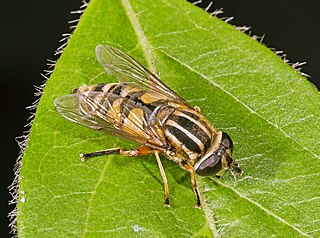
Helophilus are a diverse genus of moderate to large hoverflies, that appear somewhat bee-like. This genus comprises two subgenera: Helophilus and Pilinasica. Larvae filter-feed in organic rich water. All Helophilus adults have a distinctive lengthwise striped thorax and a transverse striped abdomen.

Parhelophilus is a genus of hoverflies. They are slightly smaller than flies of the genus Helophilus, and have a Holarctic distribution.

Eristalini is a tribe of hoverflies. Several species are well-known honeybee mimics, such as the drone fly Eristalis tenax, while other genera such as Helophilus and Parhelophilus exhibit wasp-like patterns of yellow and black stripes, both strategies to avoid predation by visual predators such as birds.

Sericomyia transversa , the Yellow-spotted Pond Fly , is an uncommon species of syrphid fly observed in northeastern North America.. Hoverflies can remain nearly motionless in flight. The adults are also known as flower flies for they are commonly found on flowers, from which they get both energy-giving nectar and protein-rich pollen. The larvae of this genus are known as rat tailed maggots for the long posterior breathing tube.
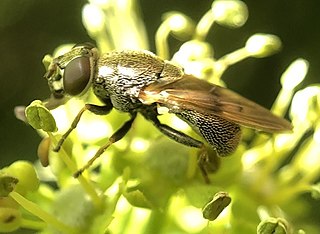
Myolepta strigilata, the Scaled Pegleg, is an uncommon species of syrphid fly observed in the eastern and central United States. Hoverflies can remain nearly motionless in flight. The adults are also known as flower flies for they are commonly found on flowers, from which they get both energy-giving nectar and protein-rich pollen. The larvae of this genus have been found in rot holes of deciduous trees.

Ceriana abbreviata , the Northern Wasp Fly , is a rare species of syrphid fly observed across North America and Canada. Hoverflies can remain nearly motionless in flight. The adults are also known as flower flies for they are commonly found on flowers, from which they get both energy-giving nectar and protein-rich pollen. The adults are wasp mimics. The larvae feed on the sap of tree wounds.

Sericomyia lata , the White-spotted Pond Fly , is a common species of syrphid fly observed across North America, concentrated in the east. Syrphid flies are also known as Hover Flies or Flower Flies because the adults are frequently found hovering around flowers from which they feed on nectar and pollen. Adults are 11.6–15.2 mm (0.46–0.60 in) long and black with large white abdominal spots. The larvae of this genus are known as rat tailed maggots for the long posterior breathing tube.

Orthonevra bellula , the Three-lined Mucksucker, is a rare species of syrphid fly found in the Southern California Hoverflies get their names from the ability to remain nearly motionless while in flight The adults are also known as flower flies for they are commonly found around and on flowers from which they get both energy-giving nectar and protein-rich pollen. Larvae for this genus are of the rat-tailed type. O. bellula larvae have not been described.

Eristalis dimidiata, the black-shouldered drone fly, is a species of hoverfly native to much of Canada and the eastern and northern United States. It flies year-round in southern areas and from late March to mid-November further north. It is one of the earliest hoverflies to fly in the spring, and as such likely overwinters as an adult. It lives primarily in forests.
Parhelophilus obsoletus , the Unadorned Bog Fly, is a fairly common species of syrphid fly observed across Canada and the northeastern and central United States. Hoverflies can remain nearly motionless in flight. The adults are also known as flower flies for they are commonly found on flowers, from which they get both energy-giving nectar and protein-rich pollen. The larvae are unknown.
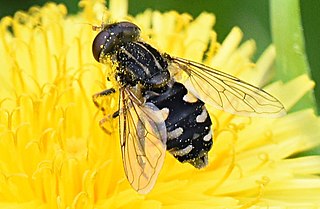
Parhelophilus rex , the Dusky Bog Fly , is a fairly common species of syrphid fly observed in northern North America. Hoverflies can remain nearly motionless in flight. The adults are also known as flower flies for they are commonly found on flowers, from which they get both energy-giving nectar and protein-rich pollen. The larvae are unknown.

Orthonevra pulchella (Williston 1887) the Dusky Mucksucker is a fairly common species of syrphid fly. It has been observed from across northern North America. Hoverflies get their names from the ability to remain nearly motionless while in flight. The adults are also known as flower flies for they are commonly found around and on flowers, from which they get both energy-giving nectar and protein-rich pollen. Larvae for this genus are of the rat-tailed type. O. pulchella larvae have not been described.

Eristalis saxorum, the Blue-polished Drone Fly, is an uncommon species of syrphid fly found along the Eastern United States. Hoverflies get their names from the ability to remain nearly motionless while in flight. The adults are also known as flower flies for they are commonly found around and on flowers, from which they get both energy-giving nectar and protein-rich pollen. The larvae are aquatic filter-feeders of the rat-tailed type. The larvae of this species have not been identified. Little is known about this uncommon species which flies from mid-March to late October.
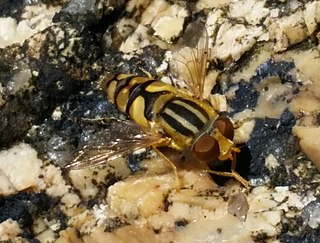
Parhelophilus laetus , the Common Bog Fly , is a common species of syrphid fly observed across northern North America. Hoverflies can remain nearly motionless in flight. The adults are also known as flower flies for they are commonly found on flowers, from which they get both energy-giving nectar and protein-rich pollen. The larvae are unknown.

Parhelophilus integer , the shiny bog fly, is a rare species of syrphid fly observed in the Eastern United States. Hoverflies can remain nearly motionless in flight. The adults are also known as flower flies, for they are commonly found on flowers from which they get both energy-giving nectar and protein-rich pollen. The larvae of this genus are the long tailed "rat-tailed" type.
Parhelophilus porcus , the black bog fly, is an uncommon species of syrphid fly observed in Northern North America. Hoverflies can remain nearly motionless in flight. The adults are also known as flower flies for they are commonly found on flowers from which they get both energy-giving nectar and protein-rich pollen. The larvae are the long tailed "rat-tailed" type.
Parhelophilus divisus the yellow-legged bog fly, is a rare species of syrphid fly observed in the northeastern United States. Hoverflies can remain nearly motionless in flight. The adults are also known as flower flies for they are commonly found on flowers, from which they get both energy-giving nectar and protein rich pollen. The larvae are the long tailed "rat-tailed" type.
Total of 245 species either found or highly expected to be found in New York.
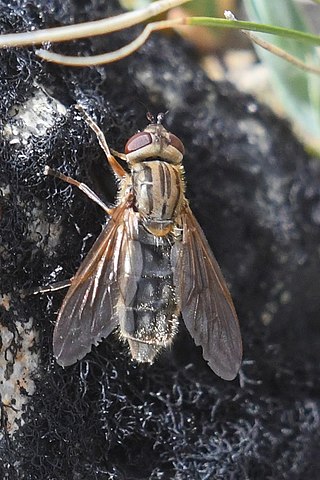
Parhelophilus brooksi is a rare species of syrphid fly observed in northern North America. Hoverflies can remain nearly motionless in flight. The adults are also known as flower flies for they are commonly found on flowers, from which they get both energy-giving nectar and protein-rich pollen. The larvae of this species are unknown but in this genera larvae are of the tong-tailed type (rat-tailed)
















